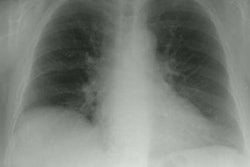AJR Am J Roentgenol 1996 Jul;167(1):101-104
The relationship of thoracic lymphadenopathy to pulmonary interstitial disease in diffuse and limited systemic sclerosis: CT findings.
Wechsler RJ, Steiner RM, Spirn PW, Rubin S, Salazar AM, Shah R, Russell K, Jimenez S, Varga J
OBJECTIVE. Mediastinal lymphadenopathy is frequently associated with interstitial lung disease (ILD) in patients with systemic sclerosis (SSc). This study compared the extent of lymphadenopathy in diffuse and limited SSc with the presence and type of ILD found on CT scans. SUBJECTS AND METHODS. Seventy-three patients with diffuse and limited SSc underwent thoracic CT. The presence of lymphadenopathy was correlated with the frequency and type of ILD. RESULTS. Fifty-eight percent (18/31) of patients with diffuse cutaneous SSc and 40% (17/42) of patients with limited cutaneous SSc had lymphadenopathy. A significant relationship was found between lymphadenopathy and the presence of interstitial disease (p = .0002). Seventy-two percent (18/25) of patients with a ground-glass parenchymal pattern of interstitial disease and 74% (14/19) of patients with a honeycomb pattern had lymphadenopathy. CONCLUSION. Lymphadenopathy is prevalent in patients with SSc and ILD regardless of clinical subtype or interstitial pattern. Lymphadenopathy appears to increase as a function of the profusion rather than the morphology of ILD.
PMID: 8659350, MUID: 96258675
